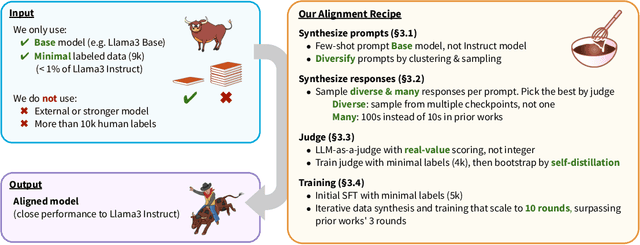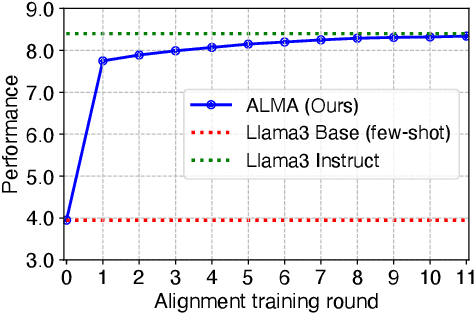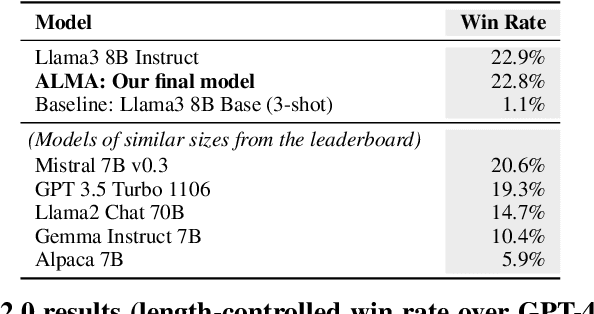Marjan Ghazvininejad
reWordBench: Benchmarking and Improving the Robustness of Reward Models with Transformed Inputs
Mar 14, 2025Abstract:Reward models have become a staple in modern NLP, serving as not only a scalable text evaluator, but also an indispensable component in many alignment recipes and inference-time algorithms. However, while recent reward models increase performance on standard benchmarks, this may partly be due to overfitting effects, which would confound an understanding of their true capability. In this work, we scrutinize the robustness of reward models and the extent of such overfitting. We build **reWordBench**, which systematically transforms reward model inputs in meaning- or ranking-preserving ways. We show that state-of-the-art reward models suffer from substantial performance degradation even with minor input transformations, sometimes dropping to significantly below-random accuracy, suggesting brittleness. To improve reward model robustness, we propose to explicitly train them to assign similar scores to paraphrases, and find that this approach also improves robustness to other distinct kinds of transformations. For example, our robust reward model reduces such degradation by roughly half for the Chat Hard subset in RewardBench. Furthermore, when used in alignment, our robust reward models demonstrate better utility and lead to higher-quality outputs, winning in up to 59% of instances against a standardly trained RM.
Multimodal RewardBench: Holistic Evaluation of Reward Models for Vision Language Models
Feb 20, 2025Abstract:Reward models play an essential role in training vision-language models (VLMs) by assessing output quality to enable aligning with human preferences. Despite their importance, the research community lacks comprehensive open benchmarks for evaluating multimodal reward models in VLMs. To address this gap, we introduce Multimodal RewardBench, an expert-annotated benchmark covering six domains: general correctness, preference, knowledge, reasoning, safety, and visual question-answering. Our dataset comprises 5,211 annotated (prompt, chosen response, rejected response) triplets collected from various VLMs. In evaluating a range of VLM judges, we find that even the top-performing models, Gemini 1.5 Pro and Claude 3.5 Sonnet, achieve only 72% overall accuracy. Notably, most models struggle in the reasoning and safety domains. These findings suggest that Multimodal RewardBench offers a challenging testbed for advancing reward model development across multiple domains. We release the benchmark at https://github.com/facebookresearch/multimodal_rewardbench.
Learning to Plan & Reason for Evaluation with Thinking-LLM-as-a-Judge
Jan 30, 2025



Abstract:LLM-as-a-Judge models generate chain-of-thought (CoT) sequences intended to capture the step-bystep reasoning process that underlies the final evaluation of a response. However, due to the lack of human annotated CoTs for evaluation, the required components and structure of effective reasoning traces remain understudied. Consequently, previous approaches often (1) constrain reasoning traces to hand-designed components, such as a list of criteria, reference answers, or verification questions and (2) structure them such that planning is intertwined with the reasoning for evaluation. In this work, we propose EvalPlanner, a preference optimization algorithm for Thinking-LLM-as-a-Judge that first generates an unconstrained evaluation plan, followed by its execution, and then the final judgment. In a self-training loop, EvalPlanner iteratively optimizes over synthetically constructed evaluation plans and executions, leading to better final verdicts. Our method achieves a new state-of-the-art performance for generative reward models on RewardBench (with a score of 93.9), despite being trained on fewer amount of, and synthetically generated, preference pairs. Additional experiments on other benchmarks like RM-Bench, JudgeBench, and FollowBenchEval further highlight the utility of both planning and reasoning for building robust LLM-as-a-Judge reasoning models.
ALMA: Alignment with Minimal Annotation
Dec 05, 2024



Abstract:Recent approaches to large language model (LLM) alignment typically require millions of human annotations or rely on external aligned models for synthetic data generation. This paper introduces ALMA: Alignment with Minimal Annotation, demonstrating that effective alignment can be achieved using only 9,000 labeled examples -- less than 1% of conventional approaches. ALMA generates large amounts of high-quality synthetic alignment data through new techniques: diverse prompt synthesis via few-shot learning, diverse response generation with multiple model checkpoints, and judge (reward model) enhancement through score aggregation and self-distillation. Using only a pretrained Llama3 base model, 5,000 SFT examples, and 4,000 judge annotations, ALMA achieves performance close to Llama3-Instruct across diverse alignment benchmarks (e.g., 0.1% difference on AlpacaEval 2.0 score). These results are achieved with a multi-round, self-bootstrapped data synthesis and training recipe that continues to improve for 10 rounds, surpassing the typical 3-round ceiling of previous methods. These results suggest that base models already possess sufficient knowledge for effective alignment, and that synthetic data generation methods can expose it.
JPEG-LM: LLMs as Image Generators with Canonical Codec Representations
Aug 15, 2024Abstract:Recent work in image and video generation has been adopting the autoregressive LLM architecture due to its generality and potentially easy integration into multi-modal systems. The crux of applying autoregressive training in language generation to visual generation is discretization -- representing continuous data like images and videos as discrete tokens. Common methods of discretizing images and videos include modeling raw pixel values, which are prohibitively lengthy, or vector quantization, which requires convoluted pre-hoc training. In this work, we propose to directly model images and videos as compressed files saved on computers via canonical codecs (e.g., JPEG, AVC/H.264). Using the default Llama architecture without any vision-specific modifications, we pretrain JPEG-LM from scratch to generate images (and AVC-LM to generate videos as a proof of concept), by directly outputting compressed file bytes in JPEG and AVC formats. Evaluation of image generation shows that this simple and straightforward approach is more effective than pixel-based modeling and sophisticated vector quantization baselines (on which our method yields a 31% reduction in FID). Our analysis shows that JPEG-LM has an especial advantage over vector quantization models in generating long-tail visual elements. Overall, we show that using canonical codec representations can help lower the barriers between language generation and visual generation, facilitating future research on multi-modal language/image/video LLMs.
SSD-2: Scaling and Inference-time Fusion of Diffusion Language Models
May 24, 2023Abstract:Diffusion-based language models (LMs) have been shown to be competent generative models that are easy to control at inference and are a promising alternative to autoregressive LMs. While autoregressive LMs have benefited immensely from scaling and instruction-based learning, existing studies on diffusion LMs have been conducted on a relatively smaller scale. Starting with a recently proposed diffusion model SSD-LM, in this work we explore methods to scale it from 0.4B to 13B parameters, proposing several techniques to improve its training and inference efficiency. We call the new model SSD-2. We further show that this model can be easily finetuned to follow instructions. Finally, leveraging diffusion models' capability at inference-time control, we show that SSD-2 facilitates novel ensembles with 100x smaller models that can be customized and deployed by individual users. We find that compared to autoregressive models, the collaboration between diffusion models is more effective, leading to higher-quality and more relevant model responses due to their ability to incorporate bi-directional contexts.
Dictionary-based Phrase-level Prompting of Large Language Models for Machine Translation
Feb 15, 2023



Abstract:Large language models (LLMs) demonstrate remarkable machine translation (MT) abilities via prompting, even though they were not explicitly trained for this task. However, even given the incredible quantities of data they are trained on, LLMs can struggle to translate inputs with rare words, which are common in low resource or domain transfer scenarios. We show that LLM prompting can provide an effective solution for rare words as well, by using prior knowledge from bilingual dictionaries to provide control hints in the prompts. We propose a novel method, DiPMT, that provides a set of possible translations for a subset of the input words, thereby enabling fine-grained phrase-level prompted control of the LLM. Extensive experiments show that DiPMT outperforms the baseline both in low-resource MT, as well as for out-of-domain MT. We further provide a qualitative analysis of the benefits and limitations of this approach, including the overall level of controllability that is achieved.
Representation Deficiency in Masked Language Modeling
Feb 04, 2023



Abstract:Masked Language Modeling (MLM) has been one of the most prominent approaches for pretraining bidirectional text encoders due to its simplicity and effectiveness. One notable concern about MLM is that the special $\texttt{[MASK]}$ symbol causes a discrepancy between pretraining data and downstream data as it is present only in pretraining but not in fine-tuning. In this work, we offer a new perspective on the consequence of such a discrepancy: We demonstrate empirically and theoretically that MLM pretraining allocates some model dimensions exclusively for representing $\texttt{[MASK]}$ tokens, resulting in a representation deficiency for real tokens and limiting the pretrained model's expressiveness when it is adapted to downstream data without $\texttt{[MASK]}$ tokens. Motivated by the identified issue, we propose MAE-LM, which pretrains the Masked Autoencoder architecture with MLM where $\texttt{[MASK]}$ tokens are excluded from the encoder. Empirically, we show that MAE-LM improves the utilization of model dimensions for real token representations, and MAE-LM consistently outperforms MLM-pretrained models across different pretraining settings and model sizes when fine-tuned on the GLUE and SQuAD benchmarks.
XLM-V: Overcoming the Vocabulary Bottleneck in Multilingual Masked Language Models
Jan 25, 2023



Abstract:Large multilingual language models typically rely on a single vocabulary shared across 100+ languages. As these models have increased in parameter count and depth, vocabulary size has remained largely unchanged. This vocabulary bottleneck limits the representational capabilities of multilingual models like XLM-R. In this paper, we introduce a new approach for scaling to very large multilingual vocabularies by de-emphasizing token sharing between languages with little lexical overlap and assigning vocabulary capacity to achieve sufficient coverage for each individual language. Tokenizations using our vocabulary are typically more semantically meaningful and shorter compared to XLM-R. Leveraging this improved vocabulary, we train XLM-V, a multilingual language model with a one million token vocabulary. XLM-V outperforms XLM-R on every task we tested on ranging from natural language inference (XNLI), question answering (MLQA, XQuAD, TyDiQA), and named entity recognition (WikiAnn) to low-resource tasks (Americas NLI, MasakhaNER).
In-context Examples Selection for Machine Translation
Dec 05, 2022Abstract:Large-scale generative models show an impressive ability to perform a wide range of Natural Language Processing (NLP) tasks using in-context learning, where a few examples are used to describe a task to the model. For Machine Translation (MT), these examples are typically randomly sampled from the development dataset with a similar distribution as the evaluation set. However, it is unclear how the choice of these in-context examples and their ordering impacts the output translation quality. In this work, we aim to understand the properties of good in-context examples for MT in both in-domain and out-of-domain settings. We show that the translation quality and the domain of the in-context examples matter and that 1-shot noisy unrelated example can have a catastrophic impact on output quality. While concatenating multiple random examples reduces the effect of noise, a single good prompt optimized to maximize translation quality on the development dataset can elicit learned information from the pre-trained language model. Adding similar examples based on an n-gram overlap with the test source significantly and consistently improves the translation quality of the outputs, outperforming a strong kNN-MT baseline in 2 out of 4 out-of-domain datasets.
 Add to Chrome
Add to Chrome Add to Firefox
Add to Firefox Add to Edge
Add to Edge